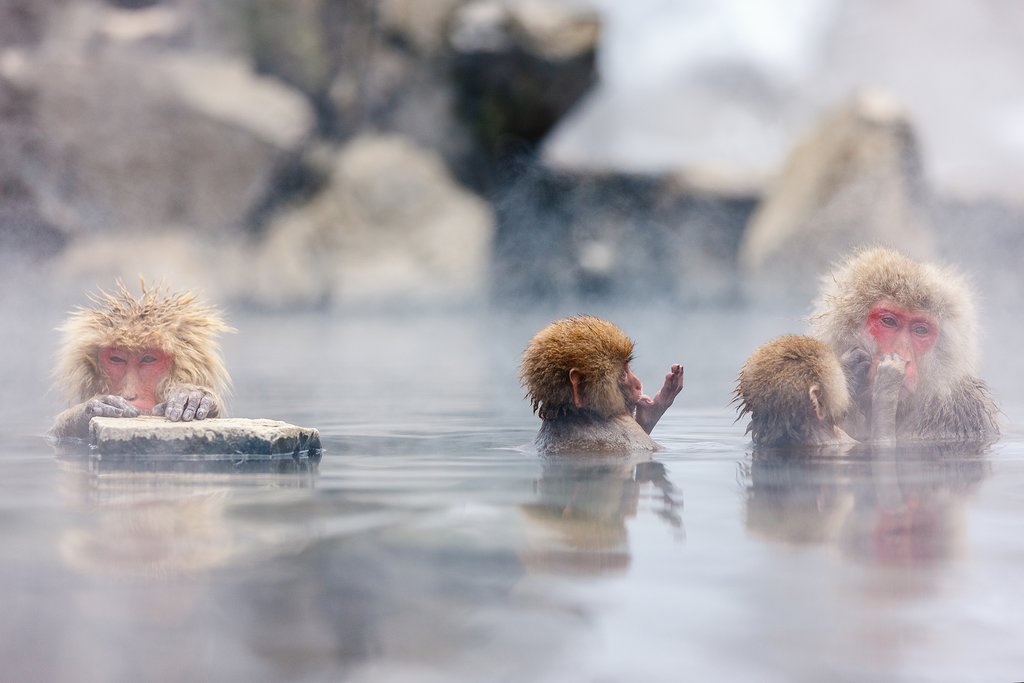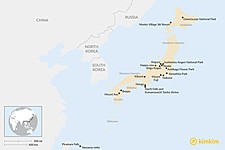
Japan's Top Natural Highlights

Hike on an Active Volcano

From iconic Fujisan (Mount Fuji) to Asosan—one of the largest active volcanoes on the planet—there are hundreds of volcanoes across Japan’s islands, and they’re just begging to be (safely!) explored.
One of the most epic hikes in the country runs for 34 miles between the active volcanoes of Asakidaku and Tokachidaku in Daisetsuzan National Park. Covering 875,54 square miles on the northernmost island of Hokkaido, this is the largest protected wilderness area in Japan.
You can stay in bare-bones mountain huts at night, but they can get busy, so it might be better to rent a tent while taking on the Daisetsuzan Grand Traverse. Day one is the hardest, with nearly 5,000 feet of ascent. All in all, count on an unforgettable experience, with plenty of boulder hopping and ropeway traversing along the way. Look out for foxes, higuma brown bears, and plenty of deer while you hike.
Take a Dip in a Natural Hot Spring

One of the most seismically active places in the world, Japan has onsen just about everywhere.
You could easily center your whole trip around visiting various hot springs. There's Joshinetsu Kogen National Park, where wild Japanese macaques—better known as snow monkeys—soak in nature’s hot tubs. For a truly unique hot spring experience, head to Beppu on the southern island of Kyushu, where you can take a crash course in cooking everything from eggs to shrimp in onsen steam.
Some other great spots to check out include the Hakone region, a couple of hours from Tokyo, where you’ll get great views of Fujisan, and Kinosaki, which is one of a few onsen near the village of Hongu on the Kumano Kodo trail. You can find more information on hiking the Kumano Kodo over 11 days here.
Chat with a local specialist who can help organize your trip.
Ski on Snow-Covered Valleys

In Japan, there are more than 600 ski resorts, and come winter they’re a powdery dream. Hokkaido gets blasted by Siberian winds through the cold months, and that’s no bad thing: the Niseko ski area, which is made up of four interlinked resorts, gets about 50 feet of snow each year.
The Japanese Alps region of Central Honshu is also known for its ski resorts. Happo-one has stunning views of the Hakuba mountains. Shiga Kogen is one of the biggest resorts on the main island, with more than 50 miles of trails. It's also worth checking out Naeba ski resort. At 3.4 miles long, its Dragondola ski lift, which connects to Kagura ski resort, is the longest in the country.
The best quality snow typically falls in January and February, so you might want to time your Japan trip for then. Also note that après-ski activities look a little different in Japan: think nabe hot pot or hearty udon noodles for dinner, a round (or three) of local craft beers, and a rowdy session of karaoke followed by a deliciously long onsen soak.
Dine on a Waterfall

Japan may not have waterfalls as intensely powerful as Niagara or Iguazu, but it does have incredibly charming cascades across the islands.
A little outside Kyoto in the village of Kibune, you can dine on top of gentle waterfalls on breezy kawadoko restaurant platforms. On Okinawa’s Yaeyama Islands, you can canoe to a beautiful waterfall among the mangroves called Pinaisara Falls.
Hike the Kumano Kodo trail and you'll get to see Nachi Taisha. One of the tallest waterfalls in the country, it's situated next to the Sanjūdō pagoda—a stunning blaze of vermillion in the forest. No wonder this one's been named one of the Three Great Waterfalls of Japan.
Enjoy a Year-Long Blossom Season

There ain’t no party like a sakura cherry blossom viewing party. Taking place from coast to coast in March and April, they involve snacks, saké, beer—even dancing!
Also in spring, delicate peach and plum blossoms start to open. You'll find pink carpets of shibazakura moss phlox to gawk at in the fields around Fujisan.
In May, it’s well worth making like a local and going to see the blooming cascades of wisteria in Ashikaga Flower Park, north of Tokyo. Come June, you can see Iris Japonica in peaceful spots like Yokohama's Yamashita Park. At the height of summer, the sunflower fields of Hokkaido are in full bloom. And it’s not just in the warmer months that you’ll see delicate blossoms spread across the city streets. Japanese apricot blooms in winter.
You can learn more about seasons in Japan, and the best times to visit the country, here.
